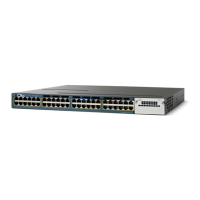29-30
Catalyst 3550 Multilayer Switch Software Configuration Guide
78-11194-09
Chapter 29 Configuring QoS
Configuring Standard QoS
Beginning in privileged EXEC mode, follow these steps to configure the port to trust the classification
of the traffic that it receives:
To return a port to its untrusted state, use the no mls qos trust interface configuration command.
For information on how to change the default CoS value, see the “Configuring the CoS Value for an
Interface” section on page 29-31. For information on how to configure the CoS-to-DSCP map, see the
“Configuring the CoS-to-DSCP Map” section on page 29-52.
Command Purpose
Step 1
configure terminal Enter global configuration mode.
Step 2
mls qos Enable QoS globally.
Step 3
interface interface-id Enter interface configuration mode, and specify the interface to be
trusted.
Valid interfaces include physical interfaces.
Step 4
mls qos trust {cos | dscp | ip-precedence} Configure the port trust state.
By default, the port is not trusted.
The keywords have these meanings:
• cos—Classifies ingress packets with the packet CoS values. For
untagged packets, the port default CoS value is used. The default
port CoS value is 0.
• dscp—Classifies ingress packets with packet DSCP values. For
non-IP packets, the packet CoS value is used if the packet is
tagged; for untagged packets, the default port CoS is used.
Internally, the switch maps the CoS value to a DSCP value by
using the CoS-to-DSCP map.
• ip-precedence—Classifies ingress packets with the packet
IP-precedence values. For non-IP packets, the packet CoS value
is used if the packet is tagged; for untagged packets, the default
port CoS is used. Internally, the switch maps the CoS value to a
DSCP value by using the CoS-to-DSCP map.
Use the cos keyword setting if your network is composed of Ethernet
LANs, Catalyst 3500 XL and 2900 XL switches, and has no more
than two types of traffic. Recall that on Catalyst 3500 XL and 2900
XL switches, CoS configures each transmitting port with a
normal-priority transmit queue and a high-priority transmit queue.
Use the dscp or ip-precedence keyword if your network is not
composed of only Ethernet LANs and if you are familiar with
sophisticated QoS features and implementations.
Step 5
end Return to privileged EXEC mode.
Step 6
show mls qos interface Verify your entries.
Step 7
copy running-config startup-config (Optional) Save your entries in the configuration file.

